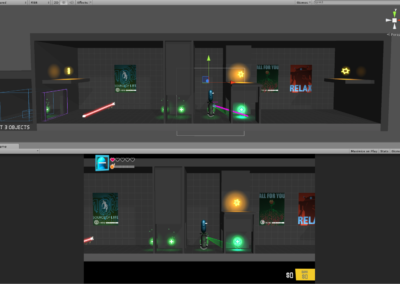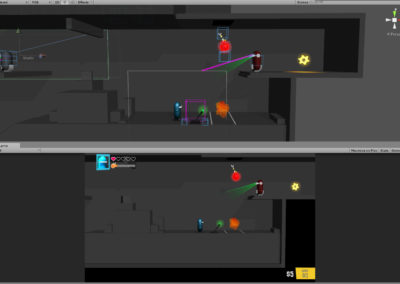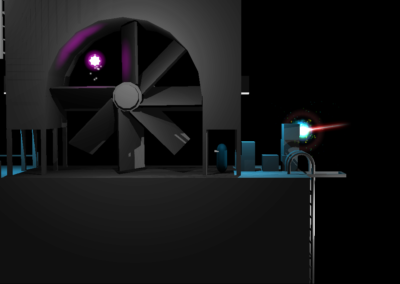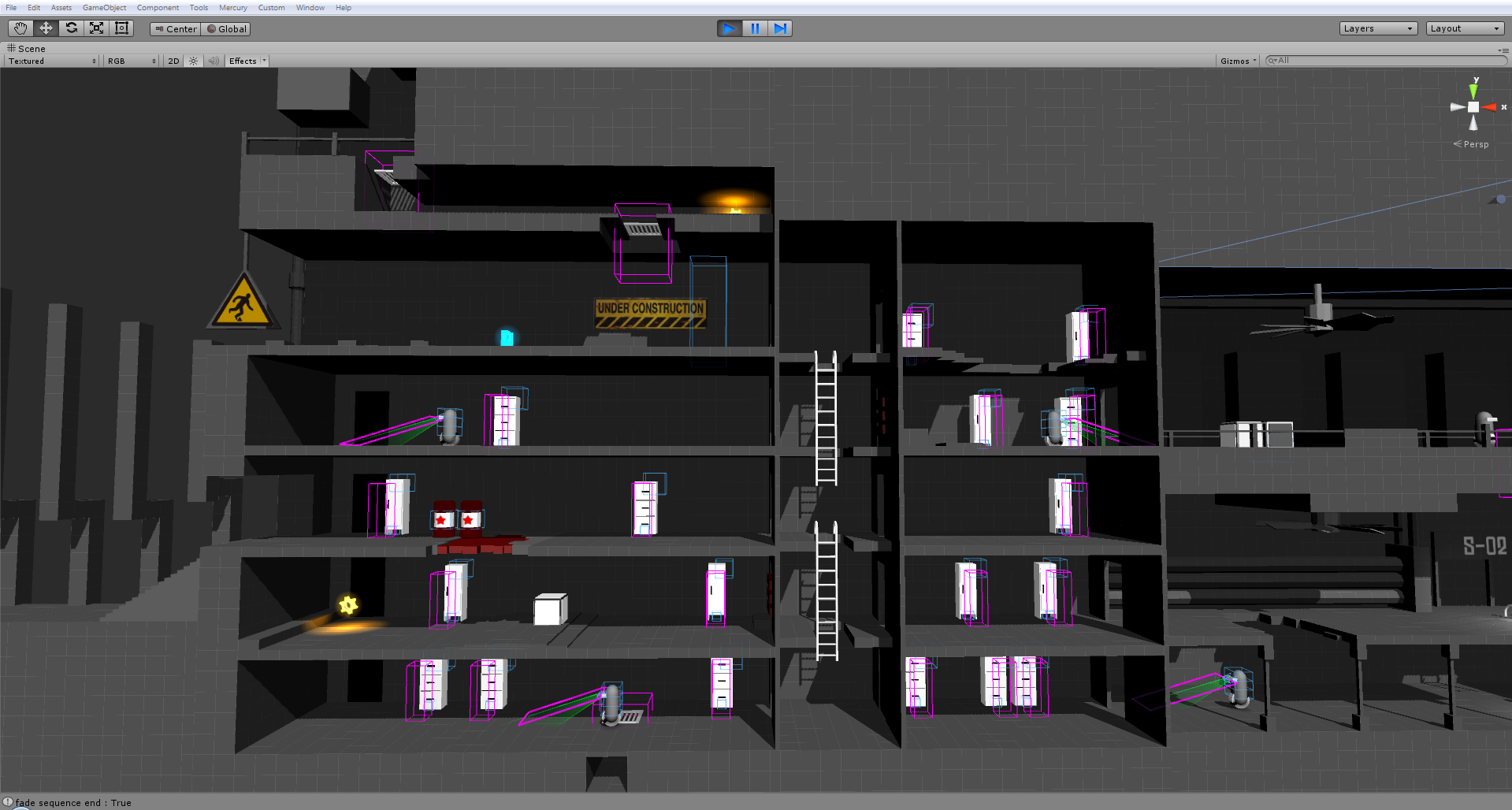Amazon Game Studios – Project X
3D “Side Scroller” Platform | Action | Stealth | Shooter
Overview
A multiplayer cooperative experience – Set in a modern corporate dystopia – THX1138 and Brazil meets Blade Runner – Players choose a balance of stealth and/or combat to explore the world and collect resources required to progress further.
Up to four players. Each player can only carry 1 weapon and have 1 ability equipped at any time. Players can move safely through world as long as they don’t violate any laws (being “scanned” in possession of any items/weapons). In an alarm state, the environment and enemies move to attack the player until the alarm abates or the player dies.
Platform XBox,1-4 player coop
Tools Unity, C#, Maya
Skills Designer, Prototyping, Scripting, AI
Project Duration 12 Weeks
Year 2015
My Role
As the designer on a small team of 4, consisting of 2 developers and a UX designer, I was responsible for designing, prototyping and implementing all levels and play interactions. The majority of my time was dedicated to design and building prototypes for new mechanics, player movement/controls, and interactions between players and the environment. I also published builds, coordinated and observed playtest sessions, and incorporated playtest feedback.
Challenges
Play must support 1- 4 players and incorporate stealth-based action as well as weapon-based combat. Starting from scratch in Unity, we would also have to balance design development with basic, foundational work like player controls, save states, etc.
Playtesting
Highly iterative, observed play sessions and web published builds with write-in feedback provided a tight, continuous, feedback loop throughout the project. Testers included team members, studio members, and employees outside of our group. Our cabal produced builds in “phases” based on design goals and play test feedback. Each phase built upon the previous play test results, learnings and our design goals.
Phase 1 – Finding the Fun
Many small, isolated prototypes to be play tested and evaluated for “fun” factor. Those that passed would be used in our short “first playable” build. Team generated ideas focussed on player movement and control, environmental threats, puzzles, and alarm/scanner systems.
Platform Play
Moving platform shields player from lasers. “Air” lift on right. Disable lasers and ride to other side.
Bomb Play
Physics based bombs can be pushed or stacked to launch other objects, including other bombs!
Iterations – Finding the Fun
- Implemented as many ideas as possible within a 2-3 week period
- Concepts must be playable by at least 2 people on our team before included in testing
- Making refinements to the player physics and controller
- Unity support/design that would enable us to configure play quickly, moving forward
Playtest Results
- Alarm and “heat” concept failed completely – no one understood it
- Opening doors – hard to detect motion moving in z-plane
- Fade Covers – Seeing into other areas was problematic. Easy to get lost when covers fade back after leaving area
- Controls “too floaty”, “imprecise”
- Laser Puzzles – Extreme, mixed reviews
Solutions
- Add “aggro” feedback to enemies – add larger “scan zone” to levels
- Doors rotate or slide upward ONLY
- Keep fade covers off once area is explored
- Controls: Increase gravity, remove double jump, hold button to control jump height (from short “hops” to high jumps)
- Retest lasers with adjusted controls. Until then, limit their use.
Phase 2 – Proof of Concept
Goal: High experiential density, high action with or without a weapon, include basic pickups and 2 enemy types. Set in outdoor environment and emphasize vertical and 3D level design elements.
Duration: 2 to 10 minutes.
Rooftops – Player Footage
Initial play tests were conducted with no weapons and with different player physics (higher jumping). This footage shows an early pass with a pistol, which wasn’t completely configured to break objects or damage turrets. This was one of the first examples of how much adding even a simple weapon could dramatically alter a level’s design.
Rooftops – Editor View
While not the player’s view, observing play from the layout view proved useful for seeing how and where AI and puzzle elements arranged themselves over time.This helped stimulate more play ideas as well as see where problems could occur.
This approach also seemed to keep the player thinking each time they moved through an area, instead of having all of the play triggered by the player. Scripted events were only used when timing was critical to a puzzle or play scenario.
Iterations – Proof of Concept
- To achieve a high experiential density, most iterations occurred around timing horizontal and vertical traversal distances, puzzles, turret attack rates and placement of interactive elements like levers, grates, and ladders.
- A great deal of time was also spent adjusting the level as refinements were made to the player physics controller.
- Because we were exploring layout concepts, any non-critical geometry based fixes would be applied to the next level design rather than tweak this layout. (For example, ladders worked, even though they were too hard to see)
Playtest Results
- Exhausting play – no visibly “safe” zones to rest – always felt under attack
- Play too linear – all players solve the level the same way
- Enemies “get in the way” – unable to jump over them with low ceilings
- Leaping into the unknown – player needs to see threats in advance
- Unseen attacks – player needs to feel accountable for failure
- Attacks off of player plane were hard to interpret
- Ladders aligned in z-plane are hard to see/use
- Dystopian theme wasn’t well served by outdoor action
- No tutorial elements – limiting our testing to skilled gamers
Solutions
- Add “safe” zones – make lower areas generally safer than upper
- Add layout “loops” – drive choice, risk vs reward, facilitate strategy
- Raise ceilings to allow jumping over enemies (unless blocking is intentional)
- Add signage for “fatal fall”. Teach Inability to know whats below = death
- Always televise attacks (scripted “warning shot” if attacker not visible)
- Removed all “off-plane” attacks
- Make all ladders player facing
- Design an indoor level with a mix of stealth and action
- Add tutorial elements to levels along critical path
Phase 3 - Refining the Experience
Goal: Design an indoor "factory-like" level with balance of high intensity and exploratory play. Add at least one new weapon and include at least one interactive environmental element used to dispatch enemies. Player must collect resources and work to exit the area alive. Include tutorial elements for new players.
Duration: 20-30 minutes
Warehouse_02 - Sub Level
- First point of entry to the factory - relatively safe area
- Items on the upper far right require Ninja Rope or Rocket Shoes to collect
- Portal on lower far right allows player to quickly travel to and from their "base"
- Added layout loops to drive meaningful choice
- All ladders are now player facing
- All doors visibly open and close
- Added push-able box tutorial element for getting up a ledge
Warehouse_02 - S02
- Player must pass through a large scanner to enter this sector (blue glowing area at lower right)
- A lever above the scanner will temporarily disable it, allowing the player to pass through undetected
- A worker (yellow hat guy) will move to turn the scanner back on
- 3rd floor is accessed from a stairwell in the next section
- Player can break boxes to find items and bombs, which can pushed down to take out enemies
- Player can safely from "drop-hang" from the 3rd floor grate to the 1st floor ladder
Warehouse_02 - Lockers
- Exploratory area - can also be used to avoid enemies in "alarm/aggro" state or lure them here to be dispatched
- Items and bombs hidden in containers - bombs can be pushed around to dispatch enemies or break walls/floors
- Some floors are only accessible from above, requiring the player to break a barrier or take a longer route
Warehouse_02 - Jump and Ride
- Secret Area - Player can either jump or return with rocket shoes to access the secret area
- Box Conveyor - players can hop on boxes on far left to grab items and return to office area
- This area was inspired by our very first metrics prototype and the ongoing refinement of our player controls
- The jumping sequence is meant to look harder than it actually is and is intended to build confidence. If the player constantly moves to the left and roughly taps the jump button in a pattern, they make it 80% of the time.
Warehouse_02 - W02B
- Upper area requires Rocket Shoes or Ninja Rope to access and fully explore
- Player can choose to bring a weapon to deal with enemies, making Rocket Shoes/Ninja Rope play easier
- Ninja Rope allows access, but isn't useful for navigating areas with moving lasers located in this area
- Lasers at the top force the player to exercise some control over the Rocket Shoes
- Bottom floor lever temporarily turns off laser gate - requires speed of Rocket Shoes, or a teammate to traverse
Warehouse_02 - W02A
- Lower area allows the player to enter safely through one scanner, however, they are tempted to pickup an item here, which will trip either scanner - causing a big battle
- Players may decide not to pickup the item and either return with a good/better weapon or plan a very speedy exit
- Ceiling mounted turrets on the far right are lethal and require either a strong weapon, faster movement, or a health boost to progress beyond this point
Iterations – Warehouse_02
- Warehouse_02 became part 2 of a larger experience developed during phase 3. Warehouse_01 connects the Player’s Base to Warehouse_02 and play focuses more on physical puzzles and environmental play.
- Enemy positioning, pathing and timing to create compelling play, puzzles, and lively atmosphere
- Pacing and flow involved tuning everything from hallway distances to how fast grates can open and close; allowing a player to respond and react to threats with confidence
- A great deal of play began to emerge as people played, such as bomb stacking, pushing, drop-hanging onto ladders, and rolling box/jump maneuvers. These elements were then better supported and reused in other parts of the level
- The addition of weapons and abilities would require heavy iteration; including the addition of vertical areas where Rocket Shoes or Ninja Rope would be required to access secret or non-critical paths
Playtest Results
- Cooperative play created numerous issues with the layout
- Players could stand on each other to reach higher areas
- As players separated, camera moved too far away
- Respawning too far away from each other was not fun
- Defeated enemies don’t drop anything
- Rocket Shoe puzzle in W-02B was too hard, early feedback mixed
- Upper items hard to see before Rocket Shoes or Ninja Rope is acquired
- Battle in W-02A is BRUTAL; particularly if the turrets are activated
- Combat engagement too short – Player can die too easily
- Jumping sequence too hard for new players
Solutions
- Add more areas where players can leverage each other
- Added shortcuts enabled only by 2+ players
- Adjust camera boundaries to limit player movement
- Revised respawn system. Players spawn next to each other
- Added random cash and item drops to defeated enemies
- Expanded W-02B space, added ceilings to “catch” players
- Extended S-02 top floor to the right, making floating items visible
- Removed a turret and spaced them further
- Added more health to level and increased player HP in general
- Adjusted the jumping platform placement to match the player speed

Phase 4 – Completing the Loop
Goal: Design an extended, replayable experience that spans multiple levels, includes an improved FUE, and leverages all current weapons and player items, enemies, and game mechanics. Player must explore the world, defeat enemies, and collect resources to expand their base, create new weapons/items, which enables them to explore further, in a continuous progression of difficulty.
Duration: 1 to 2 hours
Intro and Player Base
- Begin developing game’s dystopian theme – Art concepts for the upper area depicted a sterile, mall-like setting
- Tracking cameras proved a simple and effective way to achieve a feeling of paranoia, while areas without cameras felt safer
- Include tutorial level play for new players and testers – jump, crouch, push, break, use
- Introduce concept of base and base expansion
- Player’s Base acts as a hub for a set of 4 large, replayable level sections.
- Because we only used prototype assets, level transitions were extremely fast. Level layout size was a rough guess based on the artist’s style builds in lumberyard
What Went Well
- In roughly 12 weeks, a small team of 4 people generated 6+ hours play progression
- Built 6 complete levels and over 30 prototypes that were used in play testing
- 20+ unique mechanics developed, each evolved over time, through play
- Produced 4 weapons/attacks, 2 abilities and corresponding level design features
- Prioritizing stealth-action play resulted in proof that we could leverage it as a core experience
- Play testing revealed significant amount of emergent play that was developed into the core experience
- Established level design format and best practices that could be used throughout the game
- Observed players telling their own stories – (how they solved a level, which weapons/abilities they used, how they built their base)
- Lumberyard Team Interested in how we produced so much play in such a short time – we later presented to them
- Some people continued to play the builds cooperatively, for fun for days – enabling idea generation and iteration
What Didn’t Go Well
- Project was cancelled – moving everyone to a new project
- Combat and abilities were initially deprioritized in favor of stealth /platform action. While combat was showing great promise, it was only beginning to be developed before the project ended
- All levels had to be revisited each time the player controls were adjusted or a new weapon or ability was added
- We had more concepts than time and resources could allow. (only 4 of us)
- No direct art support – Artists built separate “style levels” influenced by the design
Do Differently
- Spend more time up front tuning player controls – Changes required all levels to be adjusted
- Spend more time up front developing weapons and abilities – their impact on level design is substantial
- Rotate more people through the cabal – we cycled through 2 different developers, both of which brought fresh thinking and went on to champion the process in the studio
- Simplify threat assessment with an “always aggro” design. If an enemy sees you, they attack. Implement our “disguise” prototype for use with scanners in a segment of the game, instead of as a core element.














